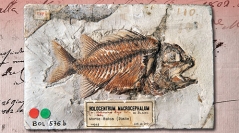

 Geodiversitas
41 (2) - Pages 11-123
Geodiversitas
41 (2) - Pages 11-123It is generally considered that the famous Gazola’s collection of fossil fishes from Monte Bolca was confiscated in May 1797 by the commissioners who accompanied in Italy the French army under the orders of Napoléon Bonaparte. The collection (“Gazola 1”) was then deposited in the Muséum National d’Histoire Naturelle, Paris (MNHN), in September 1798. Many unpublished documents, mainly from the French Ministry of the Interior, preserved in the Archives Nationales, show that Gazola was compensated by a life annuity from 1797 to which was added an annual pension granted by the French government from 1803. The seizure of the Gazola collection was thus retrospectively legalized, which explains why some commentators of the time spoke of an acquisition or a purchase. Gazola, who was the owner of a part of the quarry from which were extracted the fossils, quickly reconstituted a second collection. He did not seem to have felt too much resentment toward the French Government since, in 1803, he offered to Bonaparte, then First Consul, a part of this new collection to complete the first collection acquired by the Museum in 1798. The naturalist Louis Augustin Guillaume Bosc was commissioned to collect in Verona, in the summer of 1803, the fossil fish offered by Gazola. On this occasion, he cataloged a large part of the second Gazola collection. The French Minister of the Interior, Jean-Antoine Chaptal, ordered Bosc to bring back the entire collection of Gazola, who only wanted to give a portion of it. Against the decision of his minister, Napoleon Bonaparte intervened in person to give reason to Gazola and to cancel the mission of Bosc. Two years passed and it was finally Barthélémy Faujas de Saint-Fond who took charge of recovering in Verona the batch of fish selected by Gazola for the Museum, at the end of October 1805, while the city was the scene of clashes between the French and Austrian armies. This collection (“Gazola 2”) arrived in Paris in June 1806. The Bosc’s catalogue presented here in its entirety makes it possible to identify, in the current collections of the MNHN, some of the specimens of the collection Gazola 2.
History of palaeontology, cabinets of natural history, Monte Bolca, paleoichthyology, Chondrichthyes, Osteichthyes, Actinopterygii, lectotypifications